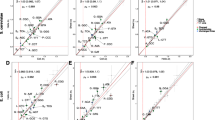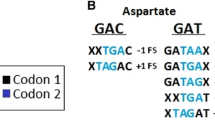Summary
Observed patterns of synonymous codon usage are explained in terms of the joint effects of mutation, selection, and random drift. Examination of the codon usage in 165Escherichia coli genes reveals a consistent trend of increasing bias with increasing gene expression level. Selection on codon usage appears to be unidirectional, so that the pattern seen in lowly expressed genes is best explained in terms of an absence of strong selection. A measure of directional synonymous-codon usage bias, the Codon Adaptation Index, has been developed. In enterobacteria, rates of synonymous substitution are seen to vary greatly among genes, and genes with a high codon bias evolve more slowly. A theoretical study shows that the patterns of extreme codon bias observed for someE. coli (and yeast) genes can be generated by rather small selective differences. The relative plausibilities of various theoretical models for explaining nonrandom codon usage are discussed.
Similar content being viewed by others
References
Bennetzen JL, Hall BD (1982) Codon selection in yeast. J Biol Chem 257:3026–3031
Bernardi G, Bernardi G (1985) Codon usage and genome composition. J Mol Evol 22:363–365
Bernardi G, Olofsson B, Filipski J, Zerial M, Salinas J, Cuny G, Meunier-Rotival M, Rodier F (1985) The mosaic genome of warm-blooded vertebrates. Science 228:953–958
Bibb MJ, Findlay PR, Johnson MW (1984) The relationship between base composition and codon usage in bacterial genes and its use for the simple and reliable identification of protein-coding sequences. Gene 30:157–166
Bonekamp F, Andersen HD, Christensen T, Jensen KF (1985) Codon-defined ribosomal pausing inEscherichia coli detected by using the pyrE attenuator to probe the coupling between transcription and translation. Nucleic Acids Res 13:4113–4123
Bulmer M (1986) Neighbouring base effects on substitution rates in pseudogenes. Mol Biol Evol 3:322–329
Fitch WM (1976) Is there selection against wobble in codon-anticodon pairing? Science 194:1173–1774
Gouy M, Gautier C (1982) Codon usage in bacteria: correlation with gene expressivity. Nucleic Acids Res 10:7055–7074
Grantham R, Gautier C, Gouy M, Mercier R, Pave A (1980) Codon catalog usage and the genome hypothesis. Nucleic Acids Res 8:r49-r62
Grantham R, Gautier C, Gouy M, Jacobzone M, Mercier R (1981) Codon catalog usage is a genome strategy modulated for gene expressivity. Nucleic Acids Res 9:r43-r79
Grantham R, Greenland T, Louail S, Mouchiroud D, Prato JL, Gouy M, Gautier C (1985) Molecular evolution of viruses as seen by nucleic acid sequence study. Bull Inst Pasteur 83:95–148
Gribskov M, Devereux J, Burgess RR (1984) The codon preference plot: graphic analysis of protein coding sequences and prediction of gene expression. Nucleic Acids Res 12:539–549
Grosjean H, Fiers W (1982) Preferential codon usage in prokaryotic genes: the optimal codon-anticodon interaction energy and the selective codon usage in efficiently expressed genes. Gene 18:199–209
Hastings KEM, Emerson CP Jr (1983) Codon usage in muscle genes and liver genes. J Mol Evol 19:214–218
Hinds PW, Blake RD (1985) Delineation of coding areas in DNA sequences through assignment of codon probabilities. J Biomol Struct Dyn 3:543–549
Honess RW, Bodemer W, Cameron KR, Niller H-H, Fleckenstein B, Randall RE (1986) The A+T-rich genome ofHerpesvirus saimiri contains a highly conserved gene for thymidylate synthase. Proc Natl Acad Sci USA 83:3604–3608
Ikemura T (1981a) Correlation between the abundance ofEscherichia coli transfer RNAs and the occurrence of the respective codons in its protein genes. J Mol Biol 146:1–21
Ikemura T (1981b) Correlation between the abundance ofEscherichia coli transfer RNAs and the occurrence of the respective codons in its protein genes: A proposal for a synonymous codon choice that is optimal for theE. coli translational system. J Mol Biol 151:389–409
Ikemura T (1982) Correlation between the abundance of yeast tRNAs and the occurrence of the respective codons in protein genes. Differences in synonymous codon choice patterns of yeast andEscherichia coli with reference to the abundance of isoaccepting transfer RNAs. J Mol Biol 158:573–598
Ikemura T (1985) Codon usage and tRNA content in unicellular and multicellular organisms. Mol Biol Evol 2;13–34
Kimura M (1968) Genetic variability maintained in a finite population due to mutational production of neutral and nearly neutral alleles. Genet Res 11:247–269
Kimura M (1981) Possibility of extensive neutral evolution under stabilizing selection with special reference to nonrandom usage of synonymous codons. Proc Natl Acad Sci USA 78:5773–5777
Kimura M (1983) The neutral theory of molecular evolution. Cambridge University Press, Cambridge, England
Kimura M (1986) DNA and the neutral theory. Philos Trans R Soc Lond [Biol] 312:343–354
King JL, Jukes TH (1969) Non-Darwinian evolution. Science 164:788–798
Konigsberg W, Godson GN (1983) Evidence for use of rare codons in the dnaG gene and other regulatory genes ofEscherichia coli. Proc Natl Acad Sci USA 80:687–691
Li W-H (1987) Models of nearly neutral mutations with particular implications for nonrandom usage of synonymous codons. J Mol Evol, in press
Li W-H, Wu C-I, Luo C-C (1984) Nonrandomness of point mutation as reflected in nucleotide substitutions in pseudogenes and its evolutionary implications. J Mol Evol 21:58–71
Li W-H, Luo C-C, Wu C-I (1985a) Evolution of DNA sequences. In: MacIntyre RJ (ed) Molecular evolutionary genetics. Plenum, New York, pp 1–94
Li W-H, Wu C-I, Luo C-C (1985b) A new method for estimating synonymous and nonsynonymous rates of nucleotide substitution considering the relative likelihood of nucleotide and codon changes. Mol Biol Evol 2:150–174
Lipman DJ, Wilbur WJ (1985) Interaction of silent and replacement changes in eucaryotic coding sequences. J Mol Evol 21:161–167
Lopes JM, Lawther RP (1986) Analysis and comparison of the internal promoter, pE, of the ilvGMEDA operons fromEscherichia coli andSalmonella typhimurium. Nucleic Acids Res 14:2779–2798
McConnell DJ, Cantwell BA, Devine KM, Forage AJ, Laoide BM, O'Kane C, Ollington JF, Sharp PM (1986) Genetic engineering of extracellular enzyme systems of Bacilli. Ann NY Acad Sci 469:1–17
Normore WM (1973) Guanine-plus-cytosine (GC) composition of the DNA of bacteria, fungi, algae and protozoa. In: Laskin AI, Lechevalier HA (eds) Handbook of microbiology, vol 2: microbial components. CRC Press, Cleveland, pp 585–740
Nussinov R (1984) Doublet frequencies in evolutionary distinct groups. Nucleic Acids Res 12:1749–1763
Ogasawara N (1985) Markedly unbiased codon usage inBacillus subtilis. Gene 40:145–150
Robinson M, Lilley R, Little S, Emtage JS, Yarranton G, Stephens P, Millican A, Eaton M, Humphreys G (1984) Codon usage can affect efficiency of translation of genes inEscherichia coli. Nucleic Acids Res 12:6663–6671
Schaaper RM, Danforth BN, Glickman BW (1986) Mechanisms of spontaneous mutagenesis: an analysis of the spectrum of spontaneous mutation in theEscherichia coli lacI gene. J Mol Biol 189:273–284
Sharp PM, Li W-H (1986) Codon usage in regulatory genes inEscherichia coli does not reflect selection for “rare” codons. Nucleic Acids Res 14:7734–7749
Sharp PM, Li W-H (1987) The rate of synonymous substitution in Enterobacterial genes inversely related to codon usage bias. Mol Biol Evol, in press
Sharp PM, Rogers MS, McConnell DJ (1985) Selection pressures on codon usage in the complete genome of bacteriophage T7. J Mol Evol 21:150–160
Sharp PM, Tuohy TMF, Mosurski KR (1986) Codon usage in yeast: Cluster analysis clearly differentiates between highly and lowly expressed genes. Nucleic Acids Res 14:5125–5143
Varenne S, Lazdunski C (1986) Effect of distribution of unfavourable codons on the maximum rate of gene expression by an heterologous organism. J Theor Biol 120:99–110
Author information
Authors and Affiliations
Rights and permissions
About this article
Cite this article
Sharp, P.M., Li, WH. An evolutionary perspective on synonymous codon usage in unicellular organisms. J Mol Evol 24, 28–38 (1986). https://doi.org/10.1007/BF02099948
Issue Date:
DOI: https://doi.org/10.1007/BF02099948




